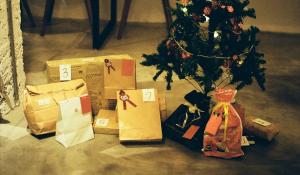
If your family tradition is to lay your (homemade, secondhand, or recycled content) gifts under a brightly decorated Christmas tree, you’ve likely wondered what the most sustainable option is to keep the festive feel while reducing your impact on the Earth.
Green America is here to help! There are a variety of Christmas tree options and ways you can make the earth-friendly choice for your family to be more sustainable.
Potted Christmas Trees
You can still enjoy decorating a tree and that delightful pine smell by selecting an organic potted tree, available at organic nurseries and some tree farms. Choose a tree that’s right for your climate, and the soil and light conditions where you will be planting it (the folks at the nursery or tree farm can help you with this). Make sure to keep it watered, since young trees are very thirsty!
You can absolutely decorate this tree but try to keep your Christmas lights to smaller and LED bulbs to prevent damaging the tree with heat.
Plant it! You can leave the tree in your house for a week and half, but then move it to the garage or patio for one day after the holiday, so it can readjust to being outside. Then plant your tree outside and water it well once it’s in the ground.
Sustainable Christmas Tree Alternatives
There are many creative ideas you can use to create a tree of your own through recovered or reusable materials. Some great ideas include:
- Using beloved books in your house, stack them in the shape of a Christmas tree and hang ornaments on the book corners.
- Look for sturdy fallen branches around your neighborhood and connect them with colorful ribbon or twine. Hang your ornaments along the branches and rejoice that there will be no need to sweep up fallen pine needles.
- Another fun idea is attaching your ornaments onto a decorative board and hanging it to your wall. This nostalgic ‘tree’ is easy to take down and store to use year after year.
Cut Trees
Almost all cut Christmas trees are harvested from tree farms, many of which are family owned and operated. These farms generally plant about two trees for every one they cut, and often use rocky soil that does not support other types of agriculture. This means that instead of barren land, the farm hosts trees that provide oxygen and combat climate change.
It’s very important to make sure that you obtain your tree from an organic tree farm, as many companies use pesticides which contaminate groundwater and are harmful to wildlife. Check out Local Harvest to find listings for organic tree farms across the country. Many conventional trees are treated with chlorpyrifos, a neurotoxin most harmful to children. A cut tree that isn’t organic might still have chlorpyrifos on it when it reaches your home.
When Christmas is over, resist any temptation to burn the tree in your fireplace after the holiday is over, since evergreen smoke will distribute pine tar in your flu and chimney, which can clog the chimney and may even catch fire.
For proper tree disposal, look for local opportunities to recycle and compost your fir friend. Visit search.earth911.com to learn the best way to recycle trees in your town. Some municipalities will accept Christmas trees after New Years for a certain amount of time.
If you have a compost pile, you can compost both organic and conventional trees, since most pesticides rapidly degrade during the composting process and do not persist in harmful concentrations.
Artificial Christmas Trees
Since live trees have the potential to harbor pollens and molds, those who suffer from severe allergies might consider an artificial tree. Artificial trees can be used year after year and are made from a combination of plastic, steel, and aluminum.
The way these trees are constructed make them unrecyclable in your municipal recycling program. Once discarded, your artificial tree will spend centuries in your local landfill. The majority of these trees also come from factories in China, where many workers spend long hours in sweatshop conditions.
While these trees can be used sustainably throughout their lifetime, the creation and disposal of them have severe consequences to people and the planet. If you already have an artificial tree, the most sustainable option is to use it for as long as you possibly can.
As for disposal, artificial Christmas trees cannot be recycled due to their mixed materials. If you need to dispose of it, check with local charities, shelters, and churches to see if they could reuse your old artificial tree. You will have the most luck in November, when thrift stores can resell.
If you’d like to learn more about small steps you can take to greener, happier festivities, check out our Green Holiday Checklist to find more tips for a more sustainable season!







